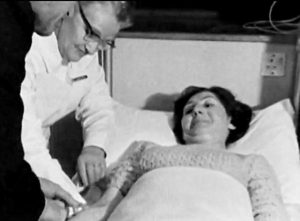
Treated like guinea pigs: TV footage of a patient having narcosis treatment.
After the First World War, society started to slowly recognise mental illness as an illness and treat it as such. The old treatments of confinement, leeches, cold baths, mercury, chains, straight-jackets, and electric shock gradually disappeared, with new approaches to treatment emerging. These included early psychotherapy methods developed by W.H.R. Rivers where doctors talked with patients about their wartime experiences, or the practice of keeping patients active with tasks such as needlework or kitchen chores (i.e. occupational therapy). These new approaches are still in use today.
After digging further it seems that other treatments were tried and tested in later years. We see treatments like hydrotherapy in the 1930s where the patient could be immersed in a bath of water overnight to relieve aggravation or an ailment. Then the 1960s arrived and the revolution in medicine drugs. Patients were sedated whilst given electroconvulsive therapy (ECT) – something that many would think disappeared in the 1920s when it was deemed unsafe. There were some patients who received brain surgery in an attempt to cure them and others were put to sleep for weeks at a time with the dreaded narcosis treatment. Many patients were women who were treated for forms of depression and eating disorders such as anorexia. Thankfully many of these treatments have disappeared to remain a part of history.
The struggle today is with anti-depressant drugs which are able to control hormones and change the way we feel. Whether to use drugs for depression, or not, is an ongoing debate. There is, however, another option and we now seem to be looking at how we can change our behaviour or think more positively with treatments like Cognitive Behaviour Therapy (CBT). Perhaps we are finally beginning to understand mental health more fully. The shame of having a mental illness is very slowly melting away, but still remains, and studies published have stated that women are 40% more likely to suffer from mental illness over than men. What is certain, however, is that the association of mental illness being solely linked with women no longer exists in its past form of extremism with men being just as likely to suffer from depression as women.
-Claire Amundson
Junior Girl
Girl Museum Inc.
